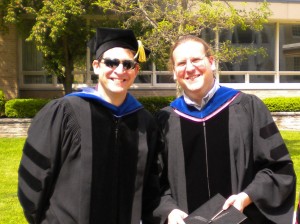My mentor and now colleague Mark Montgomery of Grinnell College has penned an essay on the social conventions of professors walking around with buds plugged in their ears.
It’s a cliché that people like me, whose computational experience began with punch cards, can feel overwhelmed by the explosion of electronic gadgets. But I find that the difficulties are less technical than emotional and social. Consider, again, my relationship to my beloved iPod. Is it OK for me to “wear” it around campus? Or does it undermine 165 years of institutional dignity for a gray-haired full professor to be seen strolling through the quads with two wires dangling from his head?
The article is in the Chronicle of Higher Education and, judging by the comments, is highly hilarious to our brethren. What I respect about it most, though, is that he manages to fit in a brief lesson on the economics of signalling near the end:
Ironically, I find that among the earphone-wearing public (that is, most people under 23), the iPod can actually enhance communication. With students I can use it to set the tone of a conversation before a single word has been uttered. Some examples: (1) One earphone removed and held poised an inch from my ear means I’m about to say: “If you want to discuss your exam grade, come to office hours.” (2) Both earphones removed, allowed to dangle: “Where is the assignment that was due on Monday?” (3) Earphones removed, wires wrapped around the iPod, device tucked in jacket pocket: “Why have I not seen you in class all week?”

Indeed.
For more from the good professor, see the essays at his website.
Professor Montgomery is tentatively slated to speak in our Economics Colloquium this coming year, so we look forward to that, too. You can check out his research interests and publications here.








 Don Gerard
Don Gerard